
Tree-lined streets and dense woodlands define much of North Alabama’s natural beauty. However, hidden challenges exist, such as common tree diseases that can silently weaken even the healthiest landscapes. These problems affect tree vitality and can damage landscapes if ignored. Addressing these issues preserves air quality, soil health, and ecological balance. Recognizing early symptoms helps save valuable trees before decline begins. Understanding the impact of these diseases is vital for anyone who appreciates North Alabama’s greenery.
Overview of Common Tree Diseases in North Alabama
The region’s humid climate supports diverse plant life but also fosters disease development. Among the most prevalent issues are blight, rust, canker, and fungal infections. Each of these conditions threatens tree health in different ways. Recognizing early signs is essential to prevent widespread decline. Common tree diseases North Alabama residents face can weaken roots, damage bark, and reduce canopy growth.
- Fungal infections causing leaf spots or rots
- Bacterial blights spreading quickly in wet seasons
- Rust diseases leaving orange or yellow markings
Identifying Symptoms of Tree Diseases
Tree ailments often reveal themselves slowly. Symptoms include wilting foliage, premature leaf drop, or cracked bark. Dark lesions and oozing sap may indicate canker disease. Rust fungi often display orange spots on leaves. In humid climates like North Alabama, such conditions progress rapidly. Detecting these issues early allows for prompt treatment. Accurate identification ensures proper responses, preventing further spread.
Rust Diseases: Types and Treatment
Rust diseases present as yellow, orange, or brown pustules on leaves. These fungi often require alternate hosts, complicating control. Effective solutions include pruning infected foliage and removing nearby host plants. Applying fungicides during early spring reduces infection risks. Improving airflow and avoiding overhead watering also help. Left untreated, rust can cause severe defoliation and tree stress.
- Remove alternate host plants
- Apply fungicides in spring
- Encourage canopy airflow
Fungal Infections: Causes and Remedies
Fungal infections thrive in North Alabama’s warm, humid climate. Root rot, leaf spots, and wood decay are frequent issues. Spores spread through soil, air, and water, often entering trees via wounds. Treatment includes pruning diseased branches and applying systemic fungicides. Improving soil drainage and structure also reduces infection chances. Regular monitoring prevents major outbreaks of common tree diseases North Alabama homeowners encounter. For long-term protection and healthier growth, consider scheduling tree trimming services in Madison AL to remove weak or infected branches before they spread disease.
Bacterial Blights: Signs and Solutions
Bacterial blights quickly damage foliage and branches. Symptoms include dark, water-soaked lesions and sudden wilting. These blights spread during wet conditions, which are common in the region. Management involves pruning infected tissues and sterilizing tools between cuts. Copper-based sprays reduce bacterial spread when applied early. Healthy irrigation and fertilization further minimize risks.
Prevention Techniques for Tree Diseases
Prevention strategies protect against widespread damage. Start with selecting resistant tree species suited for the local climate. Plant trees in well-drained soil and follow proper watering practices. Mulching around the base improves soil quality and moisture control. Regular inspections reveal early problems before they escalate. Combining cultural practices with chemical treatments when needed ensures success against common tree diseases North Alabama landscapes endure.
Importance of Timely Pruning and Maintenance
Pruning improves airflow and reduces disease-prone humidity pockets. Removing crossing, dead, or diseased branches reduces infection risks. Clean tools with alcohol or bleach between cuts to stop disease spread. In North Alabama, pruning during dry weather is ideal. Routine maintenance such as irrigation monitoring also supports healthy trees. These tasks extend tree life and resilience.
Soil Health and Tree Disease Resistance
Healthy soil supports strong root systems and disease resistance. Conducting regular soil tests ensures balanced nutrients and pH. Adding compost improves drainage in clay-heavy soils. Proper fertilization avoids excessive growth prone to fungal or bacterial infections. Introducing mycorrhizal fungi strengthens root networks. By maintaining soil health, homeowners minimize risks of common tree diseases North Alabama trees face.
Collaborating with Arborists for Professional Help
Even diligent homeowners benefit from professional assistance. Certified arborists provide accurate diagnoses and tailored treatments. They use specialized tools and local expertise to manage tree health. Arborists also apply integrated pest management, combining multiple strategies for sustainable results. Building a relationship with an arborist ensures quick responses during outbreaks. You can easily schedule expert support through the contact page.
FAQs about Tree Diseases in North Alabama
What are the most common tree diseases here?
Common tree diseases North Alabama includes rust, blight, fungal infections, and canker affecting many native species.
How do I identify a tree disease?
Look for leaf spots, bark cracks, oozing sap, or sudden wilting, especially during humid seasons.
Are fungal infections dangerous for trees?
Yes, fungal infections can damage roots, bark, or foliage, often leading to long-term decline if untreated.
Can pruning reduce disease risks?
Proper pruning improves air circulation, reducing conditions where pathogens thrive and spread across trees.
When should I call an arborist?
Call an arborist if symptoms spread rapidly or if you notice structural instability in your trees.
Preserving North Alabama’s Tree Heritage
Protecting North Alabama’s tree canopy requires vigilance, knowledge, and care. Understanding symptoms and applying preventive measures ensures healthier trees. Collaboration with certified arborists adds expert support. With consistent maintenance and monitoring, homeowners can protect trees from decline. For proactive assistance, reach out via the contact page to secure professional guidance for your property.
